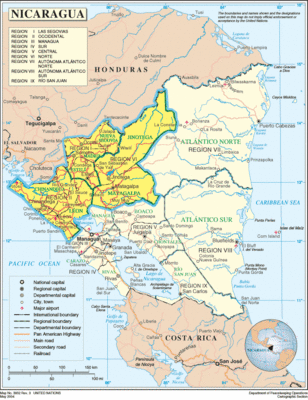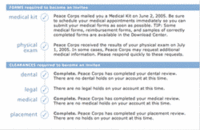More Peace Corps Specifics
 We have a lot of stuff packed up already. The shelves and photos are off the walls. Spackle already fills the nail holes in the walls. We're making some good progress.
We have a lot of stuff packed up already. The shelves and photos are off the walls. Spackle already fills the nail holes in the walls. We're making some good progress.
We thought you all might enjoy more specifics on what serving in the Peace Corps will look like, so here are some things we've recently learned about:
 Geography and climate. We will be serving in the northwest of Nicaragua, in one of three regions, I, II, or VI. Temperatures in the Central Highlands (Regions I and VI) are typically moderate, with rainfall year-round. Towards the Pacific coast (Region II), it is more hot and tropical, with distinct seasons of tropical wet (May through November) and tropical dry (December through April). We may be allowed to have some say in where we are assigned, but I suspect being married will limit our choices, since it there will be fewer host families able to entertain two people for several months.
Geography and climate. We will be serving in the northwest of Nicaragua, in one of three regions, I, II, or VI. Temperatures in the Central Highlands (Regions I and VI) are typically moderate, with rainfall year-round. Towards the Pacific coast (Region II), it is more hot and tropical, with distinct seasons of tropical wet (May through November) and tropical dry (December through April). We may be allowed to have some say in where we are assigned, but I suspect being married will limit our choices, since it there will be fewer host families able to entertain two people for several months.- The pre-service training lasts 12 weeks, starting August 31. It's located in six or seven small rural communities (population 200-5000) around the northern city of Estelí (population 150,000). Kris and I will be staying in separate towns with native host families, but we should be able to see each other frequently, since we are both in Agriculture.
- Training consists of several components, including Spanish language, technical skills, cross-cultural awareness, the role of volunteers in development, and heath and safety issues. We will attend Spanish classes and carry out technical and cross-cultural tasks in our community Monday through Friday. On Wednesday and Friday afternoons, and on Saturday mornings, the entire training group usually will come together for more formal training sessions. We will be regularly evaluated on our language, technical, cross-cultural, and safety skills.
- After the first three months of training, we are sworn in as official Peace Corps volunteers and we are assigned to a particular project in a community somewhere in the northwest of the country. For the first six weeks at least, we will be staying with another host family in the community in which we will serve, to help us acclimate to the local culture and people. After that, we are encouraged to continue to stay with a host family, but we are free to find our own housing.
- Health care relies primarily on preventive medicine, such as boiling/filtering water; washing fruits and vegetables thoroughly; vaccination against hepatitis A and B, tetanus/diphtheria, polio, typhoid, and rabies; weekly anti-malarial medication; sleeping under mosquito nets; wearing long pants and long sleeved shirts; and using insect repellent.
- Mail. Relatively dependable. Airmail to/from the US takes about two weeks, surface mail can take months. Packages sometimes mysteriously disappear, so it is best to stick with envelopes under 2 pounds. Green customs stickers are required on all packages. It is often better to just buy items in-country however, as there are well-stocked stores and supermarkets in the capital city of Managua, just a 2 hour bus ride away. While in training, our mailing address will be:
PCT "Your Name"
Voluntario del Cuerpo de Paz
Apartado Postal 3256
Managua, Nicaragua
Central America - Phones and Internet. Some cell coverage, but it rarely reaches remote areas. Most cities have a branch of ENITEL, but international calls are expensive. Most volunteers either call collect, or use international phone cards from AT&T, MCI, or Sprint. Internet cafes are fairly prevalent in major cities, but home service is expensive and rare.
- Electricity. 110v, just like the US, but there is no ground wire, so we will need to bring a two pronged adaptor. The system isn't very reliable, though, so we won't be using many electronics. We will be bringing our digital camera and a stand-alone CompactFlash CD burner to dump our pictures onto CDs. We will also be bringing a low-power MP3 cd player to listen to teachings from Church and former Ignite conferences. We purchased a lightweight Travel Safe to keep our stuff locked up in our room.
 Food and diet. Mainly rice and beans with vegetable oil and salt (gallo pinto). Also other fruits and vegetables and tons of corn products, like tamales and pinolillo, a beverage made with ground corn and cocoa. Beef, pork, and chicken are also available, although not as high of quality as US meat. Nicaragua also produces a good deal of salty cheese.
Food and diet. Mainly rice and beans with vegetable oil and salt (gallo pinto). Also other fruits and vegetables and tons of corn products, like tamales and pinolillo, a beverage made with ground corn and cocoa. Beef, pork, and chicken are also available, although not as high of quality as US meat. Nicaragua also produces a good deal of salty cheese.- Transportation. Walking, small commercial buses, and taxis, for the most part. We're not allowed to drive, but the Peace Corps may offer to purchase us bicycles.
 Currency. Nicaragua uses the córdoba (NIO). The exchange rate is about 16.37 NIO to $1.00 US.
Currency. Nicaragua uses the córdoba (NIO). The exchange rate is about 16.37 NIO to $1.00 US.
- Online resources:





